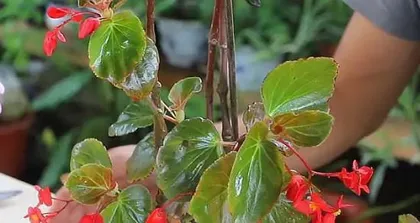Begonia is a popular ornamental plant that not only has high ornamental value but is also a potted plant that can purify indoor air. However, many people encounter a problem during the cultivation process: how often should you water a Begonia? How many days between waterings? This article will introduce the watering frequency of Begonia in detail from the aspects of its growth habits and growth environment.

I: Begonia's Growth Environment
Begonia is a plant that likes a warm and humid environment, suitable for growing in a warm, humid, and well-ventilated environment. During the high-temperature period in summer, Begonia needs shading and moisture retention to avoid leaf scorch. At the same time, Begonia also needs to grow in a well-ventilated environment to prevent the accumulation of water vapor from causing pests and diseases.
II: Begonia's Growth Habits
Begonia is a light-loving plant and needs sufficient sunlight during its growth process to ensure healthy growth. At the same time, Begonia is also a shade-tolerant plant and can grow well in a shaded environment. Begonia grows relatively fast and needs regular pruning to maintain its beauty.

III: Begonia's Watering Method
When watering Begonia, the following points need to be noted: first, choose a relatively fine nozzle so that the water can be evenly sprayed on the soil surface without damaging the leaves; second, master the timing of watering, which is generally more suitable in the morning or evening; finally, avoid overwatering or letting the soil become too dry to prevent water deficiency or waterlogged roots.
IV: Begonia's Water Amount
The amount of water for Begonia should vary with the seasons and temperature. In spring and autumn when the temperature is lower and the humidity is higher, the amount of water each time can be appropriately increased; while in summer when the temperature is higher and the humidity is lower, the amount of water needs to be reduced to avoid waterlogging.
V: Begonia's Watering Frequency
The watering frequency of Begonia should vary according to the season and growth environment. Generally speaking, watering Begonia once a week in spring and autumn is sufficient; while in summer when the temperature is higher and the humidity is lower, it needs to be watered daily to keep the soil moist.

VI: Begonia's Watering Time
The watering time for Begonia should avoid the strongest sunlight at noon or in the afternoon. You can choose to water in the morning or evening to avoid steam and leaf scorch.
VII: Begonia's Spraying Watering
During the dry summer season, you can use a spray method to water, which can increase the air humidity and is beneficial for the healthy growth of the plant. However, pay attention not to do it too frequently to avoid causing pests and diseases.
VIII: Begonia's Water Quality Requirements
Begonia has high requirements for water quality. It is not advisable to use water sources with excessive chloride ions or high hardness for watering. It is best to use distilled water or filtered tap water for watering.
IX: Begonia's Dryness Level
When the temperature is high in summer, Begonia is prone to wilting due to excessive dryness, so it needs to be watered in time. At the same time, pay attention not to overwater to avoid root rot.
X: Begonia's Soil Conditions
Begonia needs to grow in fertile, well-drained soil. Soil that is too barren or poorly drained will affect the normal growth of Begonia, so it is necessary to regularly replace the soil or apply an appropriate amount of organic fertilizer.
XI: Begonia's Light Conditions
Begonia needs sufficient sunlight to grow normally. If it grows in an environment with insufficient light, it will show symptoms such as hypoxia and yellowing leaves.
XII: Begonia's Temperature Conditions
Begonia has relatively strict requirements for temperature, with a suitable growth temperature between 18°C-25°C. If the temperature is too high or too low, it will affect the normal growth of Begonia.
XIII: Begonia's Fertilizer Application
Begonia grows relatively fast and needs regular application of appropriate organic or compound fertilizers to ensure its normal growth.
XIV: Begonia's Pest and Disease Control
Begonia is susceptible to pests and diseases such as powdery mildew, spider mites, and planthoppers, so it is necessary to regularly spray pesticides for prevention and control.
XV:
As an ornamental plant, Begonia requires careful cultivation to maintain its beautiful posture. In the watering process, pay attention to selecting the appropriate nozzle, watering timing, water amount, and watering frequency to ensure the normal and healthy growth of Begonia. At the same time, pay attention to other details of care, such as fertilizer application and pest and disease control, to make the Begonia healthier and more beautiful.